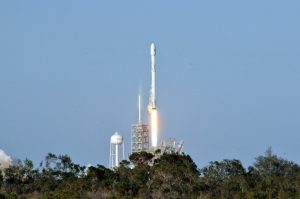There was big news in the space community two days ago as SpaceX corporation succeeded in re-using a first stage of their Falcon 9 rocket. This is the breakthrough that SpaceX has been working toward ever since Elon Musk founded the company. The huge expense of space travel today comes primarily from the fact that launch systems costing tens of millions of dollars are allowed to simply crash into the ocean after one use.

SpaceX’s plan to change that and reduce the cost of traveling into space achieved it’s first great success two years ago with the first recovery of one of it’s Falcon 9. Before Thursday’s launch SpaceX had succeeded in recovering eight of their 14 story tall first stages and now they have demonstrated their ability to completely reuse and recover their rocket for yet another launch. SpaceX plans on another 6 launches this year that will employ rockets that have already flown once and been recovered.
To watch a video of the launch from Youtube click on the link below:
https://www.youtube.com/watch?v=octU47dHdz8
To watch the landing click on the link below:
https://www.youtube.com/watch?v=VsBUByZdGLU
SpaceX hopes that they can reduce the cost of getting into space (dollars per kilo to orbit) by a third and that the increased traffic that results will allow what are called ‘economies of scale’ to come into effect.
Thursday’s launch may have been historic but in reality it will only be important if the recovery and reuse of rockets becomes a routine business.
Another important news story this week came from the International Space Station (ISS) and dealt with a rearranging of one of the station’s docking adapters as a preparation for future missions by commercial spacecraft. NASA’s commercial crew program is scheduled to begin ferrying astronauts to the ISS next year with either the launch of Boeing’s Starliner or SpaceX’s Dragon spacecraft.
During the long six and a half hour spacewalk astronauts Thomas Pesquet of the EU and NASA’s Shane Kimbrough succeeded in disconnecting the Pressurized Mating Adapter-3 (PMA-3) so that the station’s robotic arm could move it from the station’s Tranquility module to it’s Harmony module. A second spacewalk is planned to reconnect PMA-3. Once this is accomplished the ISS will be ready for docking either the Starliner or Dragon spacecraft.
To read more about NASA’s Commercial Crew Program click on the link below.
https://www.nasa.gov/sites/default/files/atoms/files/fs-2017-02-198-ksc_ccp_olia_fact_sheet_web.pdf
In a somewhat more amusing piece of news. Astrobiologist Julio Valdivia of Peru’s University of Engineering and Technology has been working with NASA’s Ames research center in Sunnyvale California to study the ability of Earth plants to survive in the environmental conditions existing on Mars and has had a major success, Potatoes. That’s right Professor Valdivia has found that the lowly Potato can both live and grow on Mars. But of course everyone who saw ‘The Martian’ already knew that.

Good post but I was wanting to know if you could write a litte
more on this subject? I’d be very grateful if you could elaborate a little bit more.
Many thanks!
Truly no matter if someone doesn’t know then its up to other
people that they will help, so here it occurs.
Thanks for the comment and come back soon!
Bob L